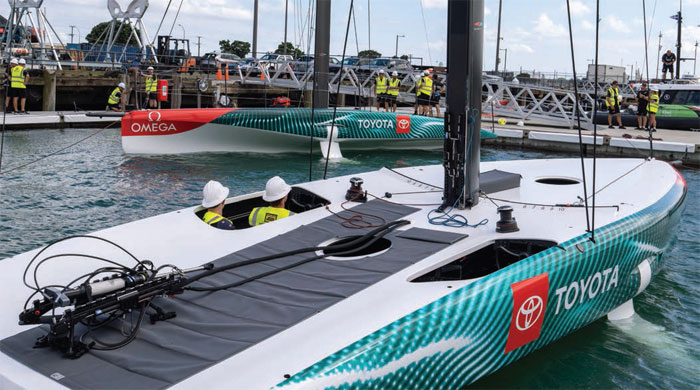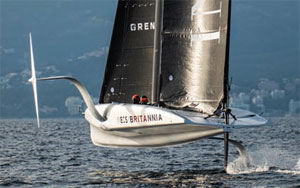

On AC40s there is plenty going on aloft as well as more obviously in the water...
Bigger isn’t always faster. In the 2013 America’s Cup in San Francisco the speed and spectacle of 72ft wingmasted cats on foils turned heads like never before. But in the next Cup cycle in Bermuda the smaller AC50s were more nimble and in some cases faster. And they were already more consistent performers.
Back then, part of the focus was on the solid wing sails. The current Cup boats have what appears to be a more conventional sailplan yet for the Southern Spars-built masts on the AC40s, this return is anything but straightforward. The rapid ascent up a staggeringly steep speed curve pushes the boundaries of design and build. It's also clear that new AC40 one-design monohulls are potent machines and punching above their weight.
The limitations of foil cavitation remain an obstacle to ever faster boats, but aero drag is also a huge factor. High apparent wind speeds mean drag that increases by the square. In this area alone the rig is a crucial factor. Add the twin-skinned mainsails and the new territory that designers find themselves in when it comes to rotating a mast while maintaining the precise shape of the main and jib and it ‘s easy to see why Southern Spars has been so busy.
‘The AC40 rigs are scaled down versions of the AC75s’ masts but that’s not to say the development has been simple,’ says Southern Spars’ Jarrad Wallace. ‘For either boat it’s been the twin-skins that set these rotating masts apart from what we’ve seen before.’

There is nothing new in rotating masts on multihulls, but those boats have a wide chainplate base which makes it easier to cater for rotation. On a monohull, the chainplate base is much narroweryou need spreaders to maintain a decent shroud angle at the mast. These spreaders articulate as the mast rotates.
‘We’ve previously built a Vismara 65 and a few Imoca 60s that had a similar system, but it’s not a common configuration. We are starting to see a trickle down into modern high-performance boats like the Mills-designed Flying Nikka and others - in this case we have two sets of spreaders to maintain the shroud angle. It’s already clear that the system works and I’m sure there’s going to be more like them.’
To achieve the articulation, the mast attachments are soft tangs for the forestay and each diagonal allowing the mast to rotate around the spreaders which use ball and socket attachments to the mast. In effect, the spreaders and rigging package remain in-plane while the mast rotates and to realise this, all rigging is by Future Fibres to create a fully integrated plug-n-play package for the teams.
‘One of the other interesting aspects of this rig configuration is that backstays are no longer necessary,’ he continues. ‘These were originally included on the AC75s to support the masthead code zeros, which were part of the original sailplan, but once it was clear that the code zeros weren’t required there was no need for the backstays which were causing drag. Of course, as we now know, it wasn’t that simple to remove them in the last Cup as the rules required they were still to be fitted. But on the AC40 we certainly don’t need them.’
Backstays are also no longer required for their other usual role, to change the shape of the sails. Instead, the use of North Sails’ structured luff Helix sails has seen a shift to controlling sail shape with the cunningham instead. But here the loads have increased significantly, which in turn has influenced the design of the mast.
‘The AC75s cunningham loads basically doubled during the last Cup which I wouldn’t be surprised if this continues to increase on the next generation.’
When it comes to the construction of the AC40 masts, again they share a great deal of the techniques that were used in the AC75 spars. The D section mast is a carbon fibre shell with a shear web of cored sandwich structure. The aluminium luff tracks are bonded onto the spar while the cunningham tracks are also aluminium and all the tangs are designed for soft strop attachments.
But while the AC75s, AC40s and Flying Nikka projects are at the leading edge of monohull foiling development, some aspects are already being applied on more conventional grand prix offshore race yachts, where Southern Spars and their high profile clients are beginning to see some very compelling results.
Click here for more information on Southern Spars »
We invite you to read on and find out for yourself why Seahorse is the most highly-rated source in the world for anyone who is serious about their racing.
To read on simply SIGN up NOW
Take advantage of our very best subscription offer or order a single copy of this issue of Seahorse.
Online at:
www.seahorse.co.uk/shop and use the code TECH20
Or for iPad simply download the Seahorse App at the iTunes store


